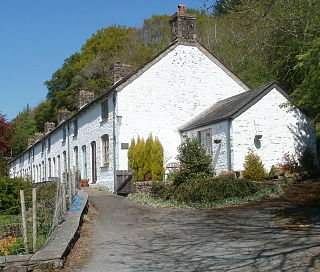Related Research Articles

Pontypool is a town and the administrative centre of the county borough of Torfaen, within the historic boundaries of Monmouthshire in South Wales. As of 2021, it has a population of 29,062.

Blaenavon is a town and community in Torfaen county borough, Wales, high on a hillside on the source of the Afon Lwyd. It is within the boundaries of the historic county of Monmouthshire and the preserved county of Gwent. The population is 6,055.

Blaenavon Industrial Landscape, in and around Blaenavon, Torfaen, Wales, was inscribed a World Heritage Site by UNESCO in 2000. The Blaenavon Ironworks, now a museum, was a major centre of iron production using locally mined or quarried iron ore, coal and limestone. Raw materials and products were transported via horse-drawn tramroads, canals and steam railways. The Landscape includes protected or listed monuments of the industrial processes, transport infrastructure, workers' housing and other aspects of early industrialisation in South Wales.

Big Pit National Coal Museum is an industrial heritage museum in Blaenavon, Torfaen, Wales. A working coal mine from 1880 to 1980, it was opened to the public in 1983 as a charitable trust called the Big Pit (Blaenavon) Trust. By 1 February 2001 Big Pit Coal Museum was incorporated into the National Museums and Galleries of Wales as the National Mining Museum of Wales. The site is dedicated to operational preservation of the Welsh heritage of coal mining, which took place during the Industrial Revolution.

Fairwater is a community and suburb of Cwmbran in the county borough of Torfaen, in south east Wales, and was built by the Cwmbran Development Corporation between 1963 and 1966.

Cwmavon is a hamlet about 2 miles south of Blaenavon and 4 miles north of Pontypool. The hamlet is part of the community of Abersychan in the county borough of Torfaen in south east Wales, and is within the boundaries of the historic county of Monmouthshire.

Blaenavon Ironworks is a former industrial site which is now a museum in Blaenavon, Wales. The ironworks was of crucial importance in the development of the ability to use cheap, low quality, high sulphur iron ores worldwide. It was the site of the experiments by Sidney Gilchrist Thomas and his cousin Percy Gilchrist that led to "the basic steel process" or "Gilchrist–Thomas process".

Monk Street is an historic street in the town of Monmouth, Monmouthshire, Wales. A portion of it was in existence by the 14th century, and appears on the 1610 map of the town by cartographer John Speed. It runs in a north-south direction, extending northward from its intersection with Whitecross Street. The name of the street relates to the nearby Priory, as well as the gate which was originally on this road and provided part of the town's defences, Monk's Gate. Monk Street is lined with numerous listed buildings.

In the United Kingdom, the term listed building refers to a building or other structure officially designated as being of special architectural, historical, or cultural significance; Grade II* structures are those considered to be "particularly important buildings of more than special interest". Listing was begun by a provision in the Town and Country Planning Act 1947. Once listed, strict limitations are imposed on the modifications allowed to a building's structure or fittings. In Wales, the authority for listing under the Planning Act 1990 rests with Cadw.

The Pwll Du Tunnel was the longest horse-powered tramway tunnel to be built in Britain at 1,875 metres (6,152 ft) in length. It started in Blaenavon, Torfaen, Wales, and was originally a coal mine, running northward almost horizontally into a hillside. Later it was extended right through the hill and used to carry limestone from quarries at Pwll Du and Tyla to the ironworks at Blaenavon, and to carry pig iron from Blaenavon to the Garnddyrys Forge. The tramway was extended past Garnddyrys to Llanfoist Wharf on the Brecknock and Abergavenny Canal. The tramway from Pwll Du to the canal fell out of use when the railway came to Blaenavon and the Garnddyrys forge was closed in 1860, but the tunnel continued to be used to carry limestone to Blaenavon until 1926. It is now a scheduled monument and part of a UNESCO World Heritage Site.

Garnddyrys Forge was an iron foundry in Wales that operated from about 1817 to 1860 about 3 km north of Blaenavon in Wales, lying on a tramroad between Blaenavon and the Brecknock and Abergavenny Canal. At one time 450 people lived around the ironworks. It became isolated when the railway took a different route to Blaenavon, and was abandoned. Although little now is visible, it is archaeologically well-preserved.

Hill's Tramroad was a 2 feet (0.61 m) gauge plateway for horse-drawn trams that connected the Blaenavon Ironworks to Llanfoist on the Brecknock and Abergavenny Canal. It ran through the Pwll Du Tunnel, past the Tyla and Pwll Du quarries, through Garnddyrys Forge and on to the Llanfoist wharf. The tramroad from Pwll Du to Llanfoist was abandoned in 1861 after the railway reached Blaenavon and Garnddyrys Forge was abandoned.

Pwll Du was a village in Monmouthshire, Wales. It was declared a slum in 1960 and demolished in 1963. The main employment was provided by nearby limestone quarries and by the iron works in Blaenavon. The Pwll Du Tunnel from Blaenavon, once the longest horse-powered tramway in Britain, ended near the village. A pub and the former Welfare Hall, now a school's outdoor pursuits centre, are all that are left standing.

The Dyne Steel Incline was a steam-powered tramroad that carried tram loads of cast iron up and over the hill between the Blaenavon Ironworks and Pwll Du. From there the trams continued along Hill's Tramroad to the Garnddyrys Forge and on to the Llanfoist wharf. It operated from around 1850 to 1860.
The Blaenavon Railroad was a horse drawn tramroad built to link Blaenavon Ironworks with the Monmouthshire Canal in south east Wales.
Thomas Hill of Dennis, also known as Thomas Hill or latterly Thomas Hill I, to distinguish him from his son, was an ironmaster, and the leading partner in the establishment of Blaenavon Ironworks in south east Wales.

Forge Row is a terrace of seven, originally twelve, cottages build around 1804 for workers at a nearby forge in Cwmavon, Torfaen, south east Wales. The cottages have been sympathetically restored. The terrace is regarded as a fine example of early housing for industrial workers in South Wales, and all the cottages are Grade II* listed buildings. The cottages lie to the east of the Afon Llwyd river.
James Ashwell (1799-1881) was an engineer and director, working in the coal, iron, and railway industries. In 1836 he helped in the formation of the Blaenavon Iron and Coal Company and was appointed resident managing director.

The Municipal Offices are in Lion Street, Blaenavon, Torfaen, Wales. The structure, which was used as the headquarters of Blaenavon Urban District Council, is a Grade II listed building.
References
- ↑ Wakelin 2011, p. 16.
- 1 2 Barber, Chris (1999). "The Iron Town of Blaenavon". Eastern Valley - The Story of Torfaen (1st ed.). Llanfoist: Blorenge Books. p. 146. ISBN 1-872730-23-X. OCLC 43459623.
- ↑ Wakelin 2011, p. 17.
- ↑ Newman, John; Lynch, Frances; Manning, William; Hughes, Stephen (2002). "Blaenavon". Gwent/Monmouthshire. Pevsner Architectural Guides (The Buildings of Wales). New Haven & London: Yale University Press. pp. 128–9. ISBN 978-0-300-09630-9. OCLC 45327986.
- ↑ "Electricity Power House, Forge Side". Historic Environment Record (HER) . Glamorgan-Gwent Archaeological Trust (GGAT). PRN GGAT04860g. Retrieved 29 April 2016. – archwilio (online database of the four Welsh Archaeological Trusts)
- ↑ "Coity House, Forgeside, Blaenavon (232708)". Coflein. RCAHMW . Retrieved 30 September 2021.
- ↑ "Zion Baptist Chapel, Forge Road, Forge Side (10493)". Coflein. RCAHMW. Retrieved 30 September 2021.
- ↑ "1st Team". Forgeside RFC. Blaenavon. Retrieved 29 April 2016.
- ↑ "Under 7s". Forgeside RFC. Blaenavon. Retrieved 29 April 2016.
- ↑ "Under 9s". Forgeside RFC. Blaenavon. Retrieved 29 April 2016.
- ↑ "Under 10s". Forgeside RFC. Blaenavon. Retrieved 29 April 2016.
- ↑ Mills, Hayley (24 September 2015). "New football club rises from the ashes". South Wales Argus . Newport . Retrieved 30 April 2016.